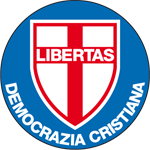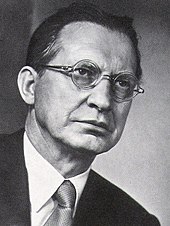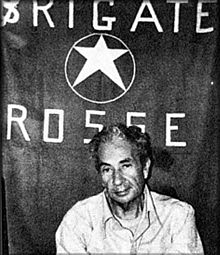Democrazia Cristiana
| Democrazia Cristiana | |

|
|
| Party leader | List of party secretaries |
| founding | December 15, 1943 |
| resolution | January 29, 1994 (published in: Partito Popolare Italiano ) |
| ideology | Christian Democracy |
| European party | EPP |
| EP Group | EPP |
| Headquarters |
|
| Party newspaper | Il Popolo |
The Democrazia Cristiana ( DC ; Italian for Christian Democracy ) was the most important political party in Italy between 1945 and 1993 and provided almost all of the prime ministers during this period. It saw itself as a moderate Catholic people 's party in the middle .
history
Foundation and political guidelines
The Democrazia Cristiana was founded on December 15, 1943, at the end of the ventennio (20 years) of the Mussolini government, by several Christian movements: members of the PPI ( Partito Popolare Italiano ) of Don Luigi Sturzo , the Azione Cattolica and the Federazione Universitaria Cattolica Italiana (FUCI). Some of the later prime ministers were among its co-founders:
- Alcide de Gasperi (Head of Government 1945–53), Mario Scelba , Attilio Piccioni and Giovanni Gronchi from the "PPI",
- Aldo Moro and Giulio Andreotti from the "Azione Cattolica"
- Amintore Fanfani and Giuseppe Dossetti from the "FUCI"
- and Giuseppe Alessi , Sicilian politician.
The content was based on Catholicism , Christian social teaching and anti-communism .
post war period
In the immediate post-war period, the DC initially participated in a unified government of all the anti-fascist parties united in the Comitato di Liberazione Nazionale , including the communists , socialists , right-wing ( PLI ) and left-wing liberals ( Pd'A , PDL , later PRI ). The DC's first prime minister was Alcide de Gasperi , who was also the DC's first secretary. In the election for the Constituent Assembly in June 1946 - the first national election after the end of fascism - the DC was by far the strongest force with 35.2%. The DC was divided over the question of the future form of government. It pushed through that a referendum was held on this and recommended its members to vote for the republic, which with 54% was able to prevail against the monarchy. Although it was clearly rooted in Catholic circles, the DC did not want to be a clerical party of the Catholic Church, but an independent people 's party (partito nazionale) . That is why she did not initially enjoy the support of the Vatican. Conservative elites, southern Italian landowners and even parts of the Catholic Church were initially skeptical of the DC - in view of their “anti-fascist consensus” with communists and socialists and a land reform ordered by the government - and supported forces standing further to the right. In the local elections in November of the same year, the Christian Democrats suffered significant losses. In the capital, Rome, they only came third behind the left-wing Popular Front and the right-wing populist "Jedermann Front" ( L'Uomo qualunque ) .
1950s: Western integration and European unification
In view of the emerging east-west conflict , the DC under De Gasperi spoke out in favor of Italy belonging to the western camp. Communists and socialists left the government in 1947, which was a prerequisite for Italy to participate in the Marshall Plan advocated by the DC. The decisive course towards integration with the West was honored by the voters in the first regular parliamentary election in April 1948 (in which communists and socialists ran together as the Popular Front): The DC gained over 13 percentage points and received an absolute majority of the seats in the House of Representatives. In the run-up, the Catholic clergy had clearly positioned themselves in favor of the DC in view of the danger of the Communists' electoral victory. The party was able to gain significantly, especially in the south. Nevertheless, De Gasperi formed coalition governments including the PRI, PLI and the moderate social democratic PSLI (later PSDI). Under DC leadership, Italy was a founding member of NATO in 1949 , even if there was resistance from within the party. In addition, the DC was clearly pro-European. De Gasperi campaigned strongly for the establishment of the coal and steel union and is one of the founding fathers of a united Europe alongside Konrad Adenauer , Jean Monnet and Robert Schuman (all Catholics and Christian Democrats) .
Fearing that the left would gain strength, the DC opened up to cooperation with the right-wing, anti-republican parties. As part of the “operazione Sturzo” - named after the progenitor of the Italian Christian Democracy Don Luigi Sturzo - she drew up joint lists of monarchists and neo-fascists ( MSI ) in the local elections in Rome . In the parliamentary elections of 1953 , the party suffered a significant setback (loss of 8 percentage points and 53 seats), while left-wing parties as well as monarchists and neo-fascists gained. Giuseppe Pella then formed a minority government of DC and non-party ministers, which was supported in parliament by monarchists and MSI. This was followed by a series of short-lived cabinets that only lasted a few months and either included the coalition partners PSDI and / or PLI or were minority DC governments that were tolerated in parliament by other parties (including the extreme right). However, the office of Prime Minister was always held by the dominant Christian Democrats: Amintore Fanfani , Mario Scelba , Antonio Segni , Adone Zoli , Fernando Tambroni . The Italian Christian Democrats campaigned strongly for the establishment of the European Economic Community (EEC) and Euratom (jointly forerunners of the European Union ), which was agreed in 1957 by the Treaty of Rome . The DC's cooperation with the extreme right ended after the events in Genoa in the summer of 1960, when bloody protests broke out in connection with the MSI party convention planned there. In 1962, however, the Christian Democrat Antonio Segni was elected President with the votes of monarchists and neo-fascists.
1960s and 1970s: opening to the left and historical compromise
In 1959 Aldo Moro was elected National Secretary of the DC. As the successor to Giuseppe Dossetti and together with Giovanni Gronchi and Amintore Fanfani, he was counted among the reformers in the party who advocated a stronger orientation towards the common good and state intervention in economic life. According to Moro, the market “should be shown the way through political decisions”. They prepared an “opening to the left” (apertura à sinistra) , which should enable a broad center-left government including the socialists. A DC government under Fanfani decided in 1962 with the votes of the PSI to nationalize the Italian power plants and implemented an educational reform after which the eight-year compulsory schooling (which theoretically had been in place since 1946) was actually implemented. In December 1963 a so-called “organic” center-left government was finally formed with the PSI under Aldo Moro, which lasted until 1968. Since that time, mostly center-left coalitions of up to five parties (possible coalition partners were PSI, PSDI, PRI and PLI) have been the norm, but at times there were short-lived DC minority governments that relied on external tolerance in parliament . Christian Democratic prime ministers during this phase were Giovanni Leone , Mariano Rumor , Emilio Colombo and Giulio Andreotti .
The state's influence on the economy, initially pursued by the left wing of Christian Democracy out of lofty goals of the common good, was perverted in later years mainly by DC politicians. High positions in the economy were filled according to the party membership, which established a clientelist system that shaped Italy into the 1980s. This opened the door to corruption and even collaboration with the Mafia .
From 1973 a " historical compromise " (compromesso storico) was discussed, which the reform-oriented, euro-communist general secretary of the PCI Enrico Berlinguer had proposed. This meant a collaboration between Christian Democrats and Communists to overcome the political division in the country. After the PCI's share of the vote in the 1976 parliamentary elections had grown closer than ever to that of the DC (38.7 against 34.4%), a DC minority government under Giulio Andreotti was established in 1976 in accordance with a pact of “national solidarity “Tolerated in parliament by the communists. However, the collaboration ended after the kidnapping and murder of Aldo Moro by the left-wing extremist Brigate Rosse (Red Brigades). Moro had campaigned for the Historical Compromise on the Christian Democratic side.
1980s: Pentapartito
In the 1980s, the Democrazia Cristiana formed a stable cartel called the Pentapartito (the “Five Party”) with PSI (which under Bettino Craxi had finally turned away from revolutionary socialism and turned to moderate social democracy), PSDI, PRI and PLI has been. Temporarily it was not the DC but its coalition partners who provided the head of government ( Giovanni Spadolini from the PRI 1981/82; Bettino Craxi from the PSI 1983-87). A low point for the DC was the European elections in 1984 , in which it was not the strongest force for the first time, but was narrowly pushed into second place by the communists (33.3 to 33.0%).
Crisis and dissolution of the DC
After the investigation by the Milan Public Prosecutor's Office in 1992 under the title Mani pulite (clean hands, corresponds to “white vest”), numerous high officials of the DC and PSI had been involved in corruption cases (see also Tangentopoli ), the DC fell into a serious crisis.
The party tried to reform itself under Mino Martinazzoli . On January 18, 1994, the leadership decided to change the party's name back to Partito Popolare Italiano (PPI) - the party from which the DC 1943 emerged. After losing an election shortly thereafter, Martinazzoli resigned and the party split into numerous factions.
Immediate offshoot of the DC
Members of the more conservative camp formed the CCD ( Centro Cristiano Democratico ) under the leadership of Pier Ferdinando Casini , a left wing of the PPI founded the CS ( Cristiano Sociali ), which was absorbed into the alliance of left-wing democrats ( Democratici di Sinistra , former communists). The CDU ( Cristiani Democratici Uniti ), on the other hand, was founded by members who wanted to belong to the center-right camp around Silvio Berlusconi . La Margherita - Democrazia è Libertà then emerged from the PPI . None of these parties exist anymore.
The following parties that still exist today expressly describe themselves as the political heirs of the Democrazia Cristiana:
- Unione dei Democratici Cristiani e Democratici di Centro (UDC), later renamed Unione di Centro (UdC), led by Pier Ferdinando Casini and Rocco Buttiglione ;
- Democrazia Cristiana: This micro-party bears the same name as the DC, especially since its chairman Giuseppe Pizza, former undersecretary of state in the Berlusconi cabinet, holds the naming rights after a long legal battle.
- Popolari-Unione Democratici per l'Europa (UDEUR) , headed by Clemente Mastella , is no longer represented in the national parliament, but is in numerous regional parliaments, provincial and city councils. For a long time, the UDEUR was represented in coalitions of the center-left and, among other things, acted as a majority funder for the Prodi II government, in whose case it was then significantly involved. In 2009 Mastella announced a collaboration with the center-right block around Silvio Berlusconi.
The DC legacy in other parties
After the merger of Margherita with the left-wing democrats , numerous Christian Democrats from the former left wing of the party found themselves in the Partito Democratico . Former Italian Prime Minister and Chairman of the EU Commission (1999-2004) Romano Prodi belongs to the Christian Democratic wing of the Partito Democratico. He had worked as Minister of Industry in a cabinet led by Giulio Andreotti. Former Democratic Party leader Dario Franceschini also began his career in the DC.
Also in Berlusconi's Popolo della Libertà or, after a renewed split, Forza Italia and Nuovo Centrodestra , many Christian Democratic politicians and voters have found their new political home. The DC offshoot Democrazia Cristiana per le Autonomie , which with Gianfranco Rotondi provided the minister for the implementation of the government program in the Berlusconi cabinet, has since disbanded and has joined the PDL. In addition, (former) ministers such as Claudio Scajola and Angelino Alfano as well as the former Lombard regional president Roberto Formigoni grew up politically in the ranks of the Democrazia Cristiana.
Incidentally, most of the politicians in the Movimento per le Autonomie , including the President of the Sicily Region, Raffaele Lombardo , are former Christian Democrats.
Election results
| year | Share of votes in percent |
|---|---|
| 1946 | 35.21 |
| 1948 | 48.51 |
| 1953 | 40.10 |
| 1958 | 42.36 |
| 1963 | 38.28 |
| 1968 | 39.12 |
| 1972 | 38.66 |
| 1976 | 38.71 |
| 1979 | 38.30 |
| 1983 | 32.93 |
| 1987 | 34.31 |
| 1992 | 29.65 |
| 1994 | 11.07 (as Partito Popolare Italiano ) |
DC Political Secretaries
The party was led by the Political Secretaries ( Segretari politici ) and National Secretaries ( Segretari nazionali ). In DC history these were:
- Alcide De Gasperi (July 1944 – September 1946)
- Attilio Piccioni (September 1946 – January 1949)
- Giuseppe Cappi (January – June 1949)
- Paolo Emilio Taviani (June 1949 – April 1950)
- Guido Gonella (April 1950 – September 1953)
- Alcide De Gasperi (2nd time, September 1953 – June 1954)
- Amintore Fanfani (June 1954 – March 1959)
- Aldo Moro (March 1959 – January 1964)
- Mariano Rumor (January 1964 – January 1969)
- Flaminio Piccoli (January – November 1969)
- Arnaldo Forlani (November 1969 – June 1973)
- Amintore Fanfani (2nd time, June 1973 – July 1975)
- Benigno Zaccagnini (July 1975 – February 1980)
- Flaminio Piccoli (2nd time, February 1980 – May 1982)
- Ciriaco De Mita (May 1982 – February 1989)
- Arnaldo Forlani (2nd time, February 1989 – October 1992)
- Mino Martinazzoli (October 1992 – January 1994)
The office of chairman of the National Party Council ( Presidente del consiglio nazionale ), on the other hand, was more of a ceremonial honorary position.
See also
literature
- Igino Giordani: Alcide De Gasperi il ricostruttore , Roma, Edizioni Cinque Lune 1955.
- Giulio Andreotti : De Gasperi e il suo tempo , Milano, Mondadori 1956.
- Pietro Scoppola: La proposta politica di De Gasperi , Bologna, Il Mulino 1977.
- Nico Perrone : Il segno della DC , Bari, Dedalo 2002.
- Luciano Radi: La Dc da De Gasperi a Fanfani , Soveria Manelli, Rubbettino 2005.
Web links
Individual evidence
- ^ Hans Woller: History of Italy in the 20th century. CH Beck, Munich 2010, p. 283.
- ^ Klaus von Beyme: The political system of Italy. Kohlhammer, Stuttgart a. a. 1970, p. 21.
- ^ Carlo Masala : The Democrazia Cristiana 1943-1963. To the development of the partito nazionale. In: Christian Democracy in Europe in the 20th Century. Böhlau, Wien 2001, pp. 348–369, on p. 355.
- ↑ Ferdinand A. Hermens: Verfassungslehre. Westdeutscher Verlag, Opladen 1968, p. 451.
- ↑ Dieter Krüger: Security through integration? The economic and political cooperation of Western Europe 1947 to 1957/58. Oldenbourg, Munich 2003, p. 79.
- ↑ Michael Minkenberg: Religion and Politics in Europe - old questions and new challenges. In: European Studies. An introduction. 2nd edition, Springer VS, Wiesbaden 2013, pp. 53–72, on p. 64.
- ^ Wolfram Kaiser: Institutional order and strategic interests. The Christian Democrats and “Europe” after 1945. In: The European project at the beginning of the 21st century. Leske + Budrich, Opladen 2001, pp. 81–98, on p. 86.
- ↑ Achim Trunk: Europe, a way out. Political Elites and European Identity in the 1950s. Oldenbourg, Munich 2007, p. 14.
- ↑ Masala: The Democrazia Cristiana 1943–1963. 2001, on p. 356.
- ^ Federico Scarano: Antonio Segni, Konrad Adenauer e l'integrazione europea. In: L'Italia nella costruzione europea. Un bilancio storico (1957-2007). Franco Angeli, Milan 2009, pp. 369-393.
- ↑ Takis S. Pappas: In Search of the Center. Conservative Parties, Electoral Competition, and Political Legitimacy in Southern Europe's New Democracies. In: Parties, Politics, and Democracy in the New Southern Europe. Johns Hopkins University Press, Baltimore / London 2001, pp. 224-267, at pp. 236-237.
- ↑ James L. Newell: The Politics of Italy. Governance in a normal country. Cambridge University Press, Cambridge 2010, pp. Xxi.
- ^ Aldo Moro: Speech at the 7th Party Congress of the DC, Naples, January 1962. Quoted from Masala: Die Democrazia Cristiana 1943–1963. 2001, p. 360.
- ↑ Masala: The Democrazia Cristiana 1943–1963. 2001, at pp. 360–361.
- ^ Dietmar Stübler: Italy's accession to the European Economic Community. The positions of the parties in the debates of the Chamber of Deputies (1957). In: Zeitschrift für Geschichtswwissenschaft , 2000, p. 607 ff., On p. 610.
- ↑ Masala: The Democrazia Cristiana 1943–1963. 2001, on p. 361.
- ^ Martin J. Bull, James Newell: Italian Politics: Adjustment Under Duress . Polity, 2005, ISBN 978-0-7456-1298-0 , p. 53.
- ^ Bernard A. Cook (Ed.): Europe Since 1945: An Encyclopedia . Taylor & Francis, 2001, ISBN 978-0-8153-4057-7 , p. 670.


